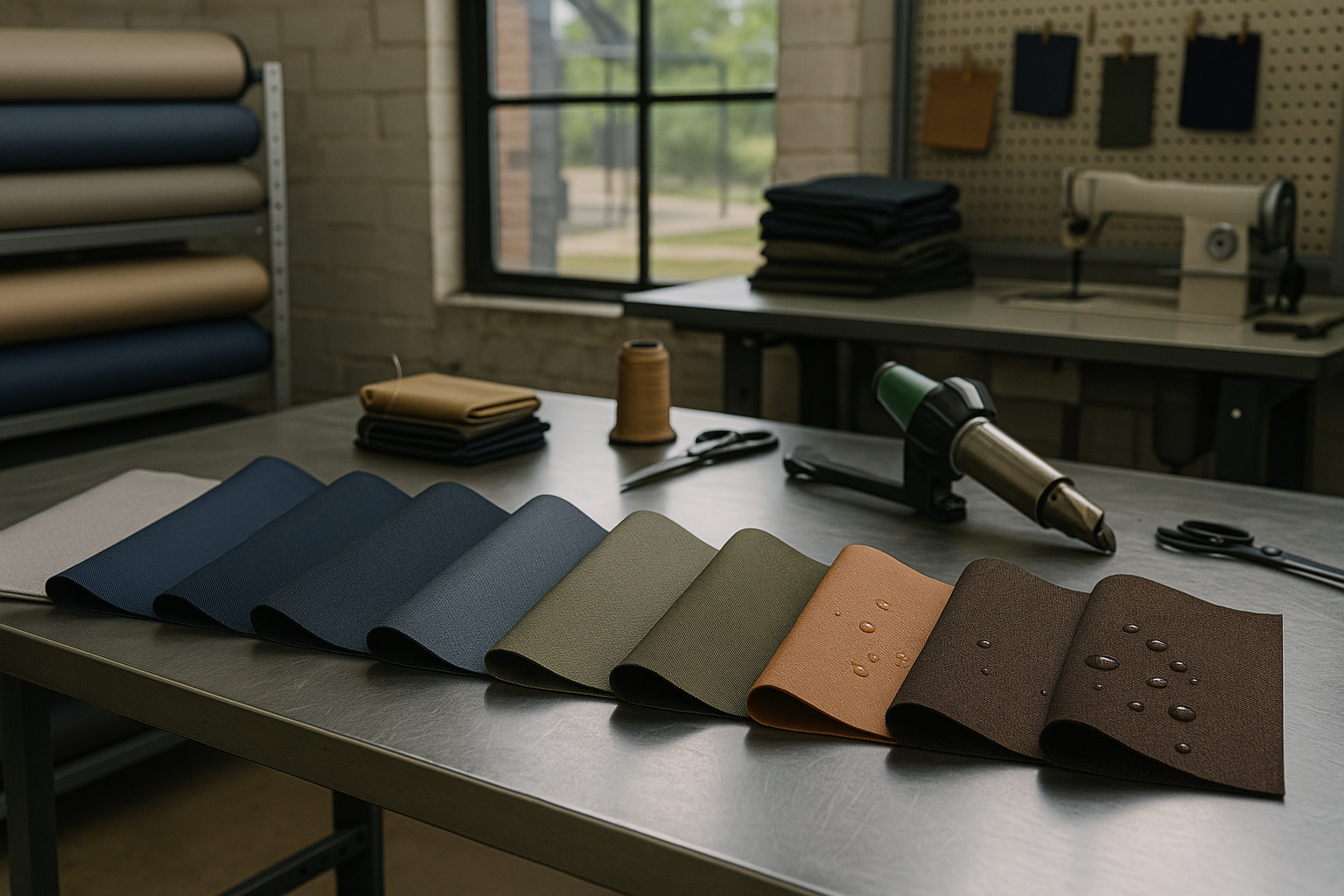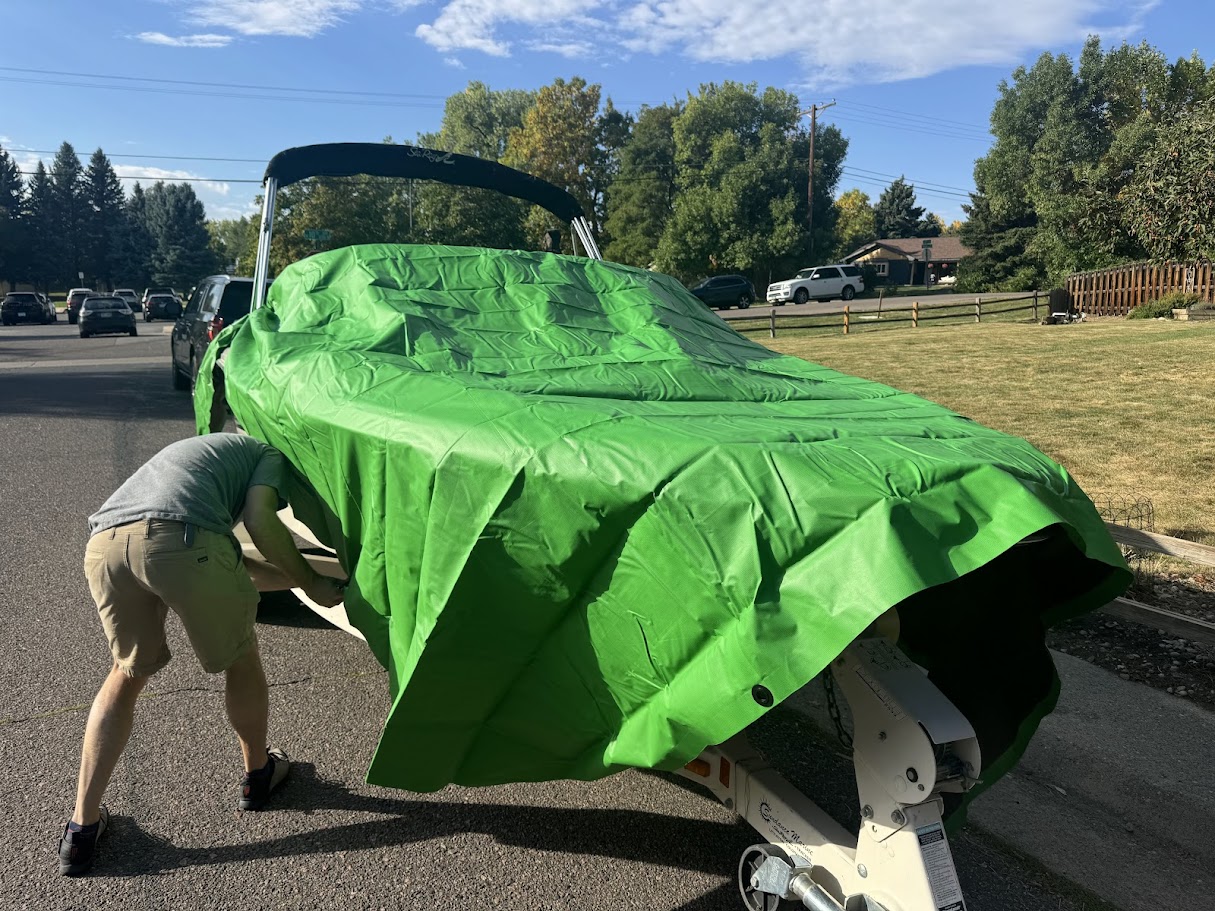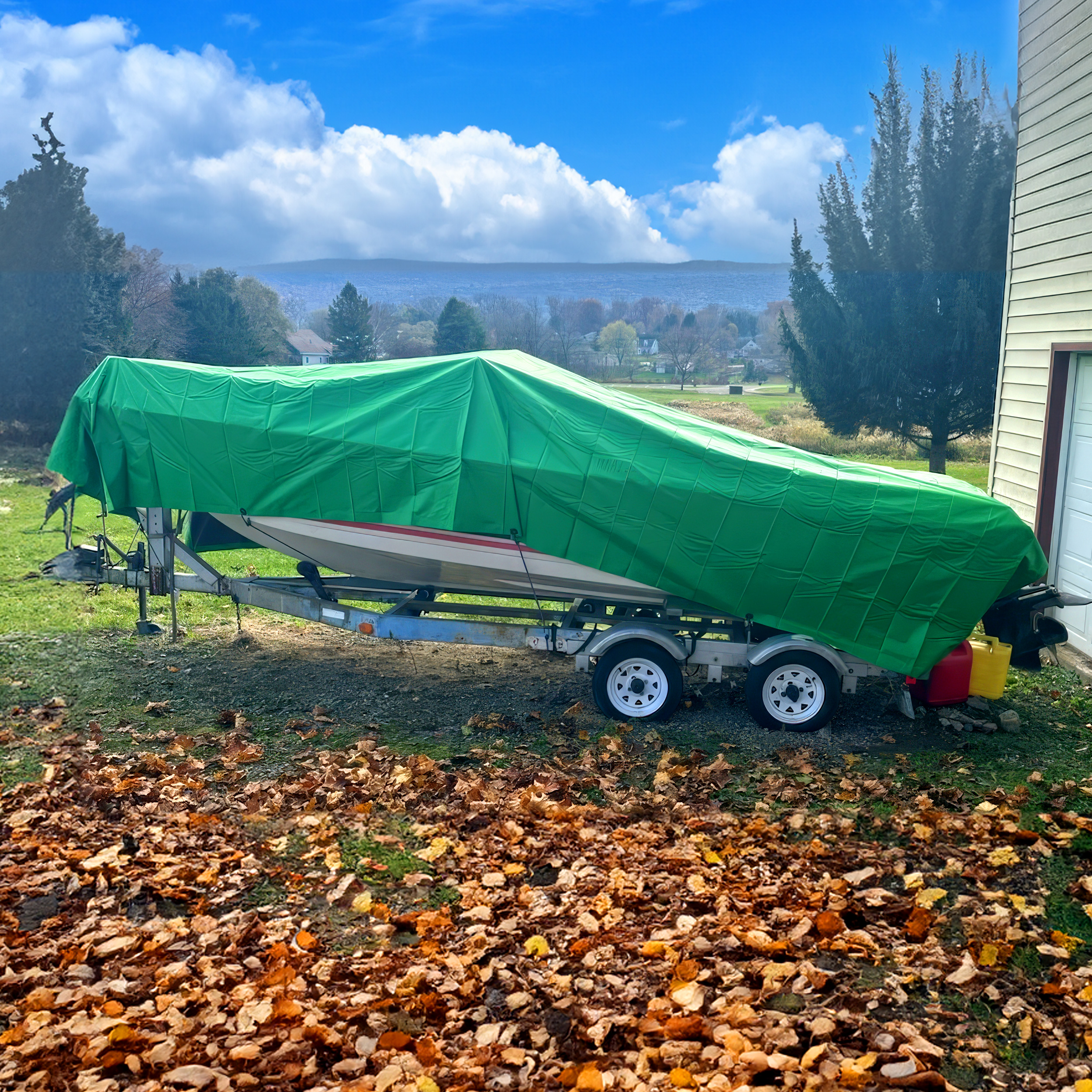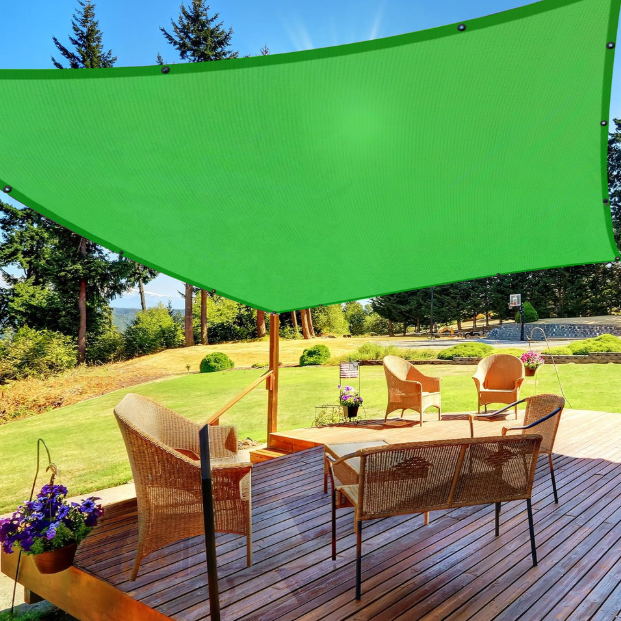
When you think of outdoor fabric…patio furniture and sunshades are probably the first things to come to mind to create your ideal outdoor living space. But there are lots of other fabrics that need to have the same durability and resistance to UV exposure for life outside.
In this article, we’ll:
- explore various endurance focused fabrics to use in your outdoor space
- highlight the key properties needed to choose the best outdoor fabric
- demonstrate how Renegade Plastics’ new performance textiles outperforms traditional options
So let’s dive in!
The 8 Most Common Applications of Outdoor Fabrics

Look around your porch, your neighborhood, the local park, and you’ll start to see the many and versatile applications of outdoor fabrics.
- Grill covers: Durable and weather-resistant, our outdoor fabrics protect grills from rust, moisture, and UV damage year-round.
- Event tents: Designed for strength and flexibility, our fabrics provide dependable shelter for outdoor events in any climate.
- Pool covers: With high UV stability and water resistance, our fabrics offer long-lasting protection and heat retention for pools.
- Storage covers: Shield equipment and materials from the elements with our heavy-duty, eco-conscious storage fabrics.
- Carports: Built to withstand sun, rain, and wind, our fabrics offer sustainable, long-term coverage for vehicles.
- Awnings: Stylish and functional, our fabrics block harmful UV rays while enhancing outdoor comfort and energy efficiency.
- Pond liners: Engineered for leak prevention and chemical resistance, our fabrics offer eco-friendly solutions for pond containment.
- Signs: Printable and resilient, our outdoor fabrics create vibrant, durable signage that stands up to sun, wind, and rain.
5 Key Factors to Consider for Your Outdoor Fabric Selection

Outdoor fabrics face unique conditions and they must hold up to the test. There are five essential properties to consider when choosing the best fabric for your outdoor space.
1. UV resistance – This is first and foremost, if a fabric cannot withstand UV radiation, then it won’t be suitable for outdoor use. UV resistance is typically tested by accelerated weathering, which simulates long-term sun exposure in a lab setting. The most common standards and methods include:
- ASTM G154 or ASTM G155: Simulate sunlight, moisture, and heat using fluorescent UV or xenon arc lamps.
- AATCC TM16: A textile-specific test that measures colorfastness to light.
- Q-SUN or QUV Testing: Machines that mimic full-spectrum sunlight—think of them as tanning beds for fabric, but less Jersey Shore and more R&D lab.
The output is usually in hours of exposure before noticeable fading, brittleness, or mechanical degradation occurs. Manufacturers typically add compounds into the outdoor fabrics to add UV resistance.
These compounds include UV Absorbers, hindered amine light stabilizers, carbon black or pigments, and reflective coatings. They protect the fabrics from UV radiation either by direct absorption of harmful rays or by stopping photochemical reactions started by UV radiation.
2. Waterproof – Most outdoor fabrics serve the dual purpose of protecting from the sun and from the rain or snow. Therefore, they must be waterproof or water resistant. The exact degree depends on your application. Water resistant fabrics can be achieved through intelligent construction with tight weaves and lamination or coatings that are inherently resistant to water penetration. Additionally, some outdoor fabrics contain surface repellents known as durable water repellents. But watch out for PFAS with those!
3. Mold and mildew resistant – Ah, mold and mildew—nature’s way of saying “your fabric wasn’t ready.” Testing for resistance to these fungal freeloaders is serious business, especially for outdoor fabrics exposed to humidity, rain, and organic grime. Here are the ASTM testing standards that manufacturers, like us Renegades, use to prove a fabric can fight the funk:
- ASTM G21 (Standard Practice for Determining Resistance of Synthetic Polymeric Materials to Fungi) tests how well a material resists fungal growth. Growth of introduced fungi is assessed after 28 days of incubation and is scored on a scale of 0 for no growth to 4 for heavy growth.
- AATCC 30 is the textile world’s version of ASTM G21. Another good indicator for mildew resistance in fabrics.
4. Chlorine resistance – Specific to pool covers, it is important that the fabrics will not fade or crack after prolonged exposure to chlorinated water.
- ASTM D543 (Resistance of Plastics to Chemical Reagents) measures how materials (like coated fabrics) resist chemical degradation, including from chlorine solutions. Samples are exposed to a chlorine solution and then post-exposure they are evaluated for changes in appearance, tensile strength, elongation, weight.
- AATCC TM162 (Colorfastness to Water: Chlorinated Pool) measures how fabric color holds up to pool water. The fabric is immersed in a chlorinated water solution for 1 hour then it’s dried, and the color change is graded on a scale from 1 (worst) to 5 (no change).
5. Cold resistant – Outdoor fabrics are not just for summer enjoyment, they need to make it through the winter as well. This often means surviving cold temperatures, ice, and snow. One common test for cold resistance is ASTM D751 at either -40 degrees F or -60 degrees F for Arctic conditions. Fun fact, -40 degrees F and -40 degrees Celsius are the same temperature!
5 Renegade Advantages for Superior Outdoor Fabrics
Renegade’s proprietary polypropylene-based fabric is a non-toxic, lightweight alternative to traditional canvas or vinyl outdoor fabrics. Our unique formulation achieves high performance in any weather without additives such as phthalates, PFAS, and lead. But don’t take our word for it, here’s a few comparisons for how we measure up to existing products for some outdoor fabric applications.
Contact us by phone (920) 348-4554 or complete our online form to discover more about how our waterproof fabrics can be a superior fit for your specific application.
1. UV Resistance
At Renegade, our polypropylene-based fabrics are engineered for long-haul exposure to all types of weather. If we say it’s UV-resistant, it’s because it survived the lab version of the Sahara on repeat. We conducted ASTM D4364 testing on our fabrics to the equivalent of 8 years of use and easily resisted cracking, mildew growth, and dirt retention. When it comes to outdoor applications, our polypropylene-based products easily meet the minimum UV resistance for numerous applications highlighted below.
| Use Case | Minimum UV Resistance (Accelerated Hours) |
|---|---|
| Short-Term Signage | 500–1,000 hrs |
| Shade Structures | 1,000–2,000 hrs |
| Vehicle Covers / Awnings | 2,000–3,000 hrs |
| Marine / Harsh Environments | 3,000–5,000+ hrs |
2. Water Resistant
Measured by hydrostatic head—the pressure (in cm H2) at which water pushes through the fabric. Renegade fabrics are at the head of the pack when it comes to hydrostatic resistance, making us your top choice when it comes to ensuring your stuff is protected from the elements.
| Hydrostatic Resistance AATCC 127 |
Product |
|---|---|
| 270+ cm | Renegade Fabrics |
| 40 cm | RECacril® Solution Dyed Acrylic Fiber |
| 20 to 50+ cm | Hydrofend Marine/Shade Fabric |
| 60 cm | Defender waterproof polyester with a polyurethane backing |
3. Mold & Mildew Resistance
No matter your outdoor fabric application, mold and mildew resistance is essential. And Renegade fabrics are clearly the perfect choice for an easy solution to replace rotting fabrics with funky smells. Our polypropylene-based fabric resists growth like a champ.
| Fabric Type | ASTM G21 Resistance Rating | Growth Risk | Why It Happens |
|---|---|---|---|
| Renegade Fabrics | 0–1 (Excellent) | Low | Hydrophobic, no organic plasticizers, no vinyl—fungus can’t get a foothold |
| PVC-Coated Vinyl | 2–4 (Moderate–High) | Medium–High | Contains plasticizers that can feed mold; traps moisture without breathability |
| Polyester (untreated) | 3–4 (High) | High | Absorbs moisture, especially in woven forms; provides a cozy condo for spores |
| Canvas (natural cotton or blends) | 4 (Severe) | Very High | Organic content + moisture = mildew paradise. Needs constant treatment. |
| Acrylic-Coated Fabric | 1–2 (Good–Moderate) | Low–Medium | Better resistance but can still trap moisture if backing isn’t breathable |
4. Chlorine Tolerance
At Renegade we have a whole line of products in blues, greens, grays, black, and white that are made to resist fading under chlorine exposure. Our products are tested to AATCC TM 162 and have all received a grade of 4.5, meaning slight to no color change.
5. Cold Exposure
Our products are all tested to ASTM D751 at -40F, and none of our fabrics crack under pressure like their vinyl counterparts. We even have a number of fabrics that have passed exposure at -50F and -60F. If you’re looking for something that’s great year round in any location, look no further.
Contact us by phone (920) 348-4554 or complete our online form to discover more about how our waterproof fabrics can be a superior fit for your specific application.
Your 5 Outdoor Fabric Questions Answered

You’ve got questions, we’ve got answers. Here’s some common questions we get about our outdoor fabrics.
1. How do I dispose of outdoor fabrics after I’m done with them?
Typically, these fabrics are destined for the landfill. They are often musty, torn, worn, and dirty. Renegade fabrics are unique in their ability to be recycled at the end of a rough outdoor life. While they can’t be placed in your curbside bin, we’re here to help you find a recycler. Our recycling program is also expanding every day, so check back in for the latest developments.
2. How do I clean outdoor fabrics?
Typically soap and water will handle dirt removal. You can also use a bleach solution on Renegade fabrics with confidence, because our colors won’t fade.
3. Are outdoor fabrics PFAS-free?
Renegade fabrics are, but we can’t speak to any other brands who often do add PFAS to add stain or water resistance to their fabrics. Note that we don’t intentionally add PFAS, and tests show non-detect levels of total fluorine. So we say “PFAS-free” and we mean it—but we don’t promise PFAS never sneaks in from the big bad world.
4. Are outdoor fabrics stain resistant? What about bird poop, sunscreen, or red wine?
Many outdoor fabrics incorporate PFAS to make the product stain resistant. Renegade’s polypropylene-based fabric is naturally stain-resistant, providing protection against anything you, or nature, throw at it.
5. Does it stretch or sag over time?
Some outdoor fabrics, such as canvas, can stretch or sag over time. And we’re all familiar with how woven polyethylene leaves shreds of polyethylene fibers everywhere. But Renegade’s outdoor fabrics are different, no stretching, no sagging, and no blue plastic strands, because the beauty of your yard matters.
Should you Consider Renegade for your Outdoor Project?

Choosing the right outdoor fabric is crucial for ensuring longevity, performance, and aesthetic appeal in any outdoor project. While many options exist, we offer a great alternative with our polypropylene-based fabrics.
Renegade’s materials provide exceptional UV, water, mold, mildew, and chlorine resistance, all while being free from harmful chemicals like PFAS.
Coupled with inherent stain resistance and ability to withstand extreme temperatures without cracking or sagging. Our fabrics stand out as a durable, sustainable, and high-performance choice for your next outdoor fabric application.
Break free from conventional plastics and elevate your outdoor space with Renegade. Contact us or call us (920) 348-4554 to discover more about our unique fabrics.
Interested in Our Fabrics?
Contact Us

